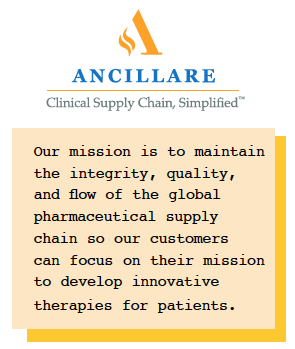Tackling Ancillary Supply Challenges with Innovative Solutions
 When a pharmaceutical client came to Joanne Santomauro nearly 15 years ago with a request to help with a complex and expensive ancillary supply challenge, she didn’t hesitate. She launched Ancillare and began the journey to create and revolutionize ancillary supply chain management for the clinical research industry. Ancillare, which is a certified woman’s owned business, offers dynamic clinical trials process management services, including ancillary and clinical supply management, regulatory compliance services, and global logistics management. “Pharma companies are looking for better, faster, less expensive ways to bring a new drug to market, ancillary supply is one piece of that equation," Joanne says.
When a pharmaceutical client came to Joanne Santomauro nearly 15 years ago with a request to help with a complex and expensive ancillary supply challenge, she didn’t hesitate. She launched Ancillare and began the journey to create and revolutionize ancillary supply chain management for the clinical research industry. Ancillare, which is a certified woman’s owned business, offers dynamic clinical trials process management services, including ancillary and clinical supply management, regulatory compliance services, and global logistics management. “Pharma companies are looking for better, faster, less expensive ways to bring a new drug to market, ancillary supply is one piece of that equation," Joanne says.
At the time, the industry’s processes were haphazard, with very little standardization. To overcome early challenges, Joanne began by educating herself and her people to understand what was special about ancillary products and their impact on clinical trials.
“I worked closely with our customers to understand the space, what were their pain points, why were they experiencing these pain points, and the different needs of each therapeutic area," she says. “For example, oncology has different needs than a metabolic or vaccine product."
She brought in experts and innovators — IT experts who really know the pharmaceutical space as well as quality and medical experts who understand the products that need to be moved around the world. And three years ago, she obtained her doctorate, with a focus on innovation and the supply  chain. She found that while there is a lot of research available on drug supply, there was nothing on ancillary supply, largely because the space is so new, complex, and diverse.
chain. She found that while there is a lot of research available on drug supply, there was nothing on ancillary supply, largely because the space is so new, complex, and diverse.
Innovation, she believes, needs to be informed by research, both academic and practitioner. “I think about how applying a new model or innovation will work in ancillary supply, what are the risks, and what the market needs," she says. “For me, it’s all about research, research, research, learn, design, pilot, test, release, and then test, test, test again." To drive innovation at Ancillare, Joanne engages her teams and pharma clients to share ideas. The key she says is understanding how an innovation will affect the lives of patients.
“We’re moving products that touch the sickest patients who are looking for cures," she says. “With the innovations that we implement — whether IoT or AI or data analytics — we need to be sure what we’re predicting is really what will work in the marketplace, because the patient is at the end of that line." (PV)










